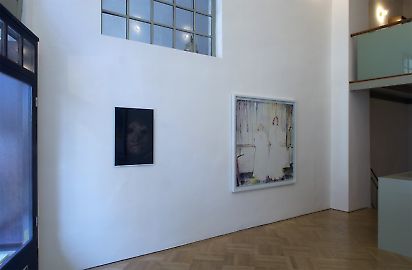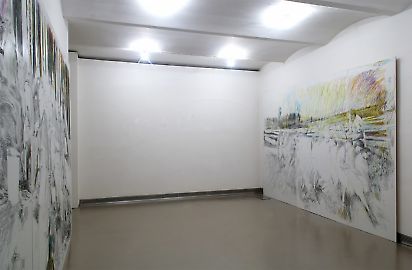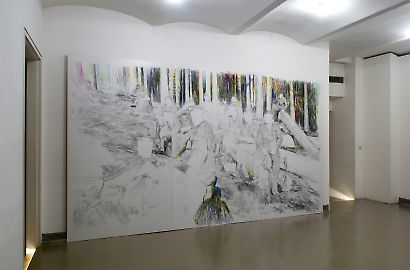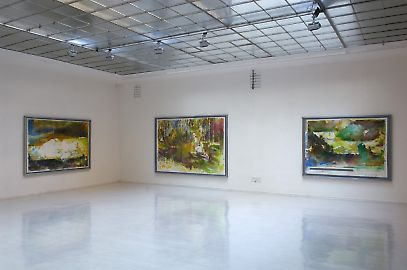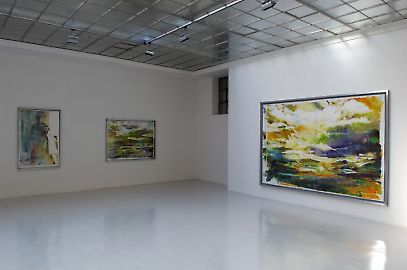Martin Dammann -- Zweite Totale
In his pioneering essay The Work of Art in the Age of Its Technical Reproducibility,(1) Walter Benjamin uses the term “aura” to describe that certain something that is lost by the artwork when it is duplicated by technical means. German artist Martin Dammann reverts the process described by Benjamin, returning something of their lost aura to his technically reproduced source material—in this case archival photographs—by way of painting.
In his current exhibition, Dammann presents a series of large format drawings of watercolor landscapes, along with enlarged archival photographs, drawings of reclining women, strange “illustrations” of objects produced with a scanner. If we were to look for a single term to describe the commonalities in these works done in different techniques and formats, it would be “landscape” in the broadest sense of the term. Martin Dammann is not satisfied with commenting on the First and Second World War, even though his works use vintage photos of that time. Dammann’s pictures are neither bloody nor violent; they do not overwhelm the beholder with horrifying images or martial statements. They rather attest to the artist’s interest in the notion of history, on the one hand investigating the way we look at documents and the emotions conveyed by archival imagery (for instance family photographs, even if not showing our own relatives). In Benjamin’s words, "It is useful to illustrate the notion of aura, proposed above for historical objects, by using the concept of the aura for natural objects. We define the latter as the singular appearance of a remoteness, however close it may be. Following with our eyes a mountain range on the horizon or a branch which casts its shadow over you as you rest on a summer afternoon: that is breathing the aura of those mountains, of that branch.“(1)
The exhibition Zweite Totale (a German cinema term that refers to an overview of the entire scene) is based on a project that took several months to complete. The aim was to create a series of landscapes that on the one hand dealt with nature, or more precisely, the notion of nature and its inherent romanticism.
Five large-size watercolors are on view in the gallery’s main room, the central part of the exhibition, and around these paintings the other artworks in the exhibition have been assembled. The conspicuous absence of human figures in these works is counterbalanced by a series of small drawings showing loved ones. But it would be a mistake to locate the aforementioned romanticism in either the human figures or the emptiness of the landscape, since it is ultimately concealed within the desiring and loving eye of the person who took the original photographs on which the artist’s works are based.
In a broad sense, the exhibition also explores the question, "What is war?" For besides soldiers and weapons, war is always also about landscape. On the one hand, the warring parties see a landscape with a strong desire to take possession of it. Accordingly, some of the images used by Martin Dammann are aerial reconnaissance photographs, taken from planes that flew over purportedly strategic positions (including Mont Saint-Michel in Normandy, where the similarity to an army facility is hard to see). They are images that the artist does not immediately transform to watercolors, for alone their detail-true photographic enlargement allows the foundational characteristics of the original to be clearly recognized and refer to "that singular appearance of a remoteness" which Benjamin detected in the aura. Secondly, through the bombing and shooting that occurs in war, and the subsequent redrafting of borders on the map, the entire landscape undergoes a transformation along with the victor’s assertion of ownership over the desired territory. Finally, the landscape is appropriated because both its image and reality have changed; the possession of both “the desired territory and its modified version” completes the process. This triple logic “of observing, transforming and possessing” also underpins Martin Dammann’s latest series of works. The artist starts by observing the original images; he then draws or paints them, and thus interprets what he has observed, finally taking complete hold of the images by exposing their hidden qualities, or should we say, “aura”? Like Benjamin’s mountains or treebranch, Dammann’s pictures most likely deal with "remoteness, however close it may be.”
(1) Walter Benjamin, Das Kunstwerk im Zeitalter seiner technischen Reproduzierbarkeit (Frankfurt am Main: Suhrkamp, 1966), p. 15.
Text: Thibaut de Ruyter


